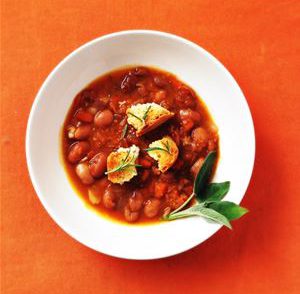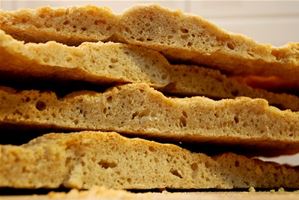Tuscan hunting season is officially open. With about 100,000 hunters renewing their licences annually in the region alone, hunting here is serious business. And, with locals from Momigno (population 1,000), a small town on the way to Femminamorta in the hills above Pistoia, the cinghiali (wild boar), don’t stand a chance.
I know a few people in Tuscany with their own reserves (some with their own personal capocaccia, or hunting guide), who themselves shoot the odd wild boar or deer and take clients with them to hunt, but I only recently discovered over a plate of pappardelle al cinghiale followed by grilled cinghiale ribs that the rules of the hunt are as complicated as anything in Italy. (Che sorpresa!)
My friend Luca, from Momigno, explained the hunt to me. Squadre (teams) for each territory need official registration, a boss and at least 50 members, all of whom must take a hunting course. They must re-register annually and renew their firearm licences every six years. If on the day of the hunt less than 20 hunters show up, the hunt cannot officially proceed.
Hunting days are specified by law with three days per week assigned to each locality during the season. Momigno’s official hunting days for this season are Wednesday, Saturday and Sunday. (As you can imagine, absenteeism from work is quite common during Italy’s hunting season).
The teams work year-round training their dogs, scattering granturco in the forest Hansel-and-Gretel style to keep the boars full-bellied and out of local farmers’ crops, and erecting protective electric fences.
On the day of the hunt, the team divides into canai (the men with the dogs), postaioli (the men in position with rifles) and tracciatori (the trackers).
A typical 6:30am start to the hunt involves 20 tracciatori searching for fresh traces. Once done, they go back to the base to confer with the capocaccia, who decides on the best zone. The 30-50 postaioli form a horseshoe close to the fresh tracks, keep still and wait.
At around 10am the 10 canai come along, each with seven or eight trained dogs. At the capocaccia’s command, they release their dogs in hopes of flushing out a cinghiale and directing it towards the horseshoe-shaped trap of the gun-wielding postaioli.
Hunters may shoot only straight ahead, so even if a hunter sees the boar first, but it is not directly in front of him, he must wait for his fellow postaiolo to shoot so as not to endanger the lives of others. Occasionally, trees get the bullets instead, and in Momigno the yearly awards ceremony rewards the person who shoots the most air, as well as the person who bags the biggest cinghiale. Last year, the squadra Momigno finally killed a legendary six- or seven-year-old boar weighing 130kg that they had been chasing for more than three seasons: it had killed a number of the village dogs and damaged local crops over the years.
For the 2009-2010 season, Italy introduced a law that boar from the hunt can be sold to restaurants. Depending on whom you ask, this may or may not reduce the chronic poaching problem. Five times per season, each squadra must take a piece of the heart and a piece of the liver of a cinghiale they have hunted to the local authorities for testing.
Once the boar has been shot, it is taken to the hunting headquarters in the heart of Momigno, weighed, identified by its teeth for age, and written in the records; then it is hung and bled, skinned and left for two days at 0°C to frollare-develop flavour and relax the flesh. Then the team divides the boar, with each person on the hunt getting a piece. If it is a mature boar (over two years old), the piece that Luca brings home is often made into a tasty dish that I love, cinghiale con olive e brandy.
RECIPE
Wild Boar with olives and Brandy
If you are lucky enough to get your hands on a leg or two of freshly killed wild boar, debone the meat, remove the sinews and cut into hefty cubes. Marinate overnight in half a bottle of brandy for every two kilograms of meat (yes, really!), a teaspoon of crushed juniper berries, some bay leaves, parsley stalks and a few peppercorns.
The next day, drain the meat and set aside the marinade.
Finely dice a red onion, two sticks of celery and a small carrot, sauté in a heavy-based pan in half a cup of extra virgin olive oil, then remove the vegetables and turn up the heat. Add the diced cinghiale (ensuring it is dry), in stages, to brown. Once this is done, throw everything back in the pot with the marinade and some sea salt, and cover with cold water. Bring to a boil and leave to simmer for a few hours until tender, stirring with a wooden spoon without breaking up the large dices of cinghiale. Halfway through the cooking, add a drained jar of good quality black olives (with pits), and one or two diced, mature red tomatoes.
At the end, finish with two spoonfuls of soft butter and serve. I like to present this dish on top of a grilled slice of bread lavished with salt and olive oil, to eat after the meat, when all the juices soak in.
Buon appetito!
WINE MATCH
Wild boar with olives and brandy make for an intensely flavoured dish, so a big wine is needed. I like to drink Bolgheri wines with my cinghiale, and a wine that holds its own with this dish is Argentiera 2005 DOC Tenuta Argentiera. Made with cabernet sauvignon, merlot and cabernet franc, it is intense with liquorice and blueberry aromas. The merlot in the blend gives the impression of drinking liquid silk, and the balance comes from the two cabernets, offering a robust enough structure to stand up to the wild boar.







